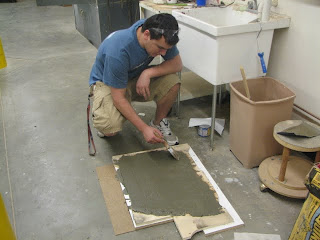Friday, May 7, 2010
2010 Digifab Assembly Rodeo
Wednesday, May 5, 2010
Digitally Fabricated Coffee Table
Tuesday, April 27, 2010
Double Curved Surface Assignment

 The mold was produced by CNC machine with foam material. Parallel finishing was used directly in engraving the material because foam is soft and fast cutting and this technique will not harm the cutting tool.
The mold was produced by CNC machine with foam material. Parallel finishing was used directly in engraving the material because foam is soft and fast cutting and this technique will not harm the cutting tool.


In the second try, the thickness was increased to about 3.5 cm to avoid the breaking. Before pouring the concrete mixture on the foam mold, I used Petroleum jelly to facilitate the process of separating the concrete block from the foam.


Monday, April 5, 2010
Developable Boxes
Thursday, March 11, 2010
Skin and Bones Paneling
In the first iteration, the bones were required to be extremely small in scale to allow it to read as a doubly curved surface and ultimately could have resulted in the failing of the project. It had printed but because the 3d printer had malfunctioned in saying the glue was full and it was actually empty it did not print. Due to the time sharing amongst our own group and other groups we decided to work with the other two iterations of the group.
Idea: The idea behind the surface was to create a paneling system for exploration. This frame would be able to accept any panel as long as it could relate to the different dimensions that the system presents. Those shapes area a four sided polygon and a six sided polygon. The angles and actual dimensions differ from every panel. This allows for situational experimentation.



















































